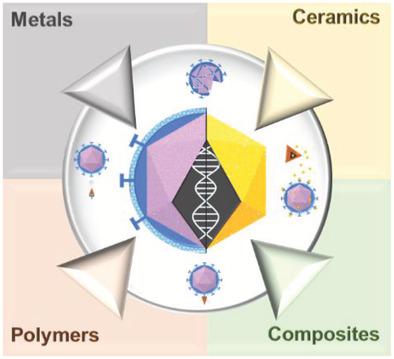当前位置:
X-MOL 学术
›
Part. Part. Syst. Charact.
›
论文详情
Our official English website, www.x-mol.net, welcomes your feedback! (Note: you will need to create a separate account there.)
From Bulk to Nanoparticles: An Overview of Antiviral Materials, Its Mechanisms, and Applications
Particle & Particle Systems Characterization ( IF 2.7 ) Pub Date : 2021-06-26 , DOI: 10.1002/ppsc.202100044 Isabella C. P. Rodrigues 1 , Kaio N. Campo 2 , Clarice W. Arns 3 , Laís P. Gabriel 4 , Thomas J. Webster 5 , Éder S. N. Lopes 1
Particle & Particle Systems Characterization ( IF 2.7 ) Pub Date : 2021-06-26 , DOI: 10.1002/ppsc.202100044 Isabella C. P. Rodrigues 1 , Kaio N. Campo 2 , Clarice W. Arns 3 , Laís P. Gabriel 4 , Thomas J. Webster 5 , Éder S. N. Lopes 1
Affiliation

|
Infectious diseases caused by viruses are a global health concern and have become prominent in light of the recent COVID-19 pandemic. Considering the limitations of drugs and prophylactic methods used in current medicine, antiviral materials are a useful strategy in preventing the spread of viruses and enhancing treatment efficiency. Thus, this review highlights the state-of-the-art antiviral materials, describes the scientific landscape of the primary antiviral materials used based on bibliometric analysis, presents their mechanisms of action, and discusses their clinical applications. The mechanisms of action underlying the broad-spectrum antiviral properties of metals, ceramics, polymers, and composites are also discussed. Polyanions, polycations, oxides, and metal-based materials, from bulk to nanoparticles, have good potential in antiviral applications that may help prepare the world for future viral breakouts.
中文翻译:

从散装到纳米颗粒:抗病毒材料、机制和应用概述
由病毒引起的传染病是一个全球性的健康问题,并且鉴于最近的 COVID-19 大流行而变得突出。考虑到当前医学中使用的药物和预防方法的局限性,抗病毒材料是防止病毒传播和提高治疗效率的有用策略。因此,这篇综述重点介绍了最先进的抗病毒材料,描述了基于文献计量分析所使用的主要抗病毒材料的科学前景,介绍了它们的作用机制,并讨论了它们的临床应用。还讨论了金属、陶瓷、聚合物和复合材料的广谱抗病毒特性的作用机制。聚阴离子、聚阳离子、氧化物和金属基材料,从大块到纳米颗粒,
更新日期:2021-08-12
中文翻译:

从散装到纳米颗粒:抗病毒材料、机制和应用概述
由病毒引起的传染病是一个全球性的健康问题,并且鉴于最近的 COVID-19 大流行而变得突出。考虑到当前医学中使用的药物和预防方法的局限性,抗病毒材料是防止病毒传播和提高治疗效率的有用策略。因此,这篇综述重点介绍了最先进的抗病毒材料,描述了基于文献计量分析所使用的主要抗病毒材料的科学前景,介绍了它们的作用机制,并讨论了它们的临床应用。还讨论了金属、陶瓷、聚合物和复合材料的广谱抗病毒特性的作用机制。聚阴离子、聚阳离子、氧化物和金属基材料,从大块到纳米颗粒,


























 京公网安备 11010802027423号
京公网安备 11010802027423号